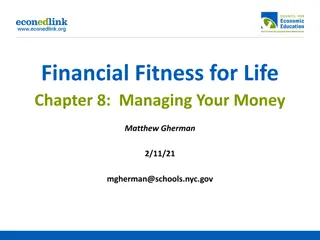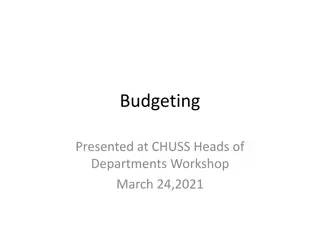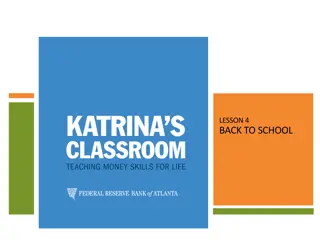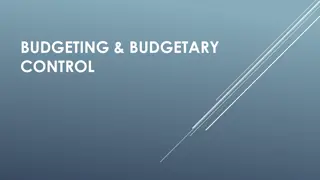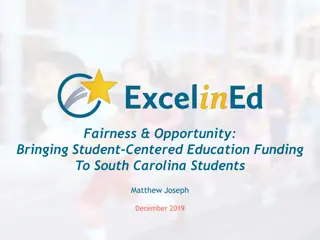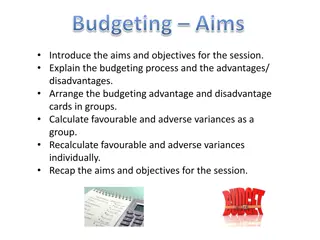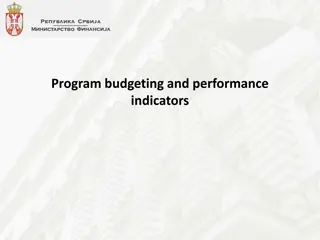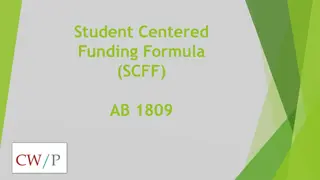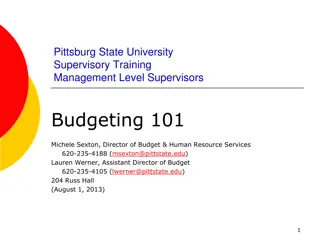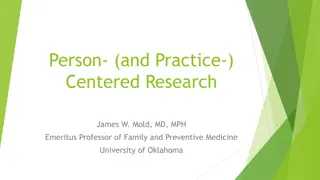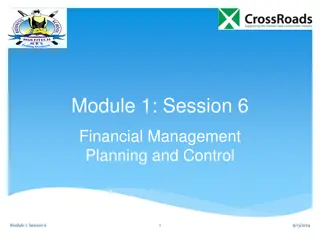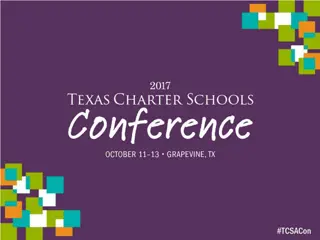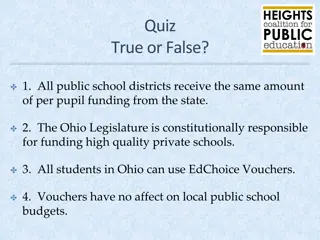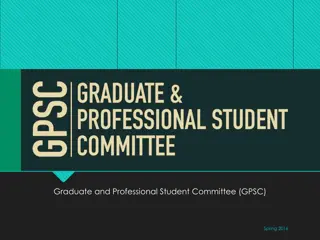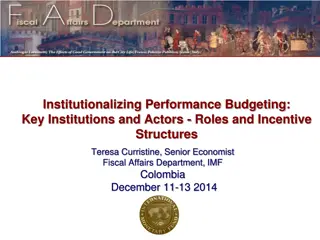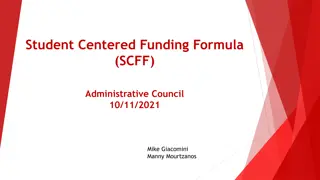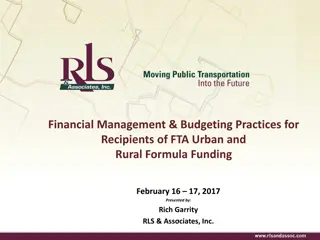Student-Centered Budgeting for School Funding
Different Weighted Models for Budgeting in Student-Centered Budgeting aim to ensure fair allocation of resources by considering student needs beyond just enrollment numbers. Ground rules and parameters are set to protect school funding and align budget methodologies with district priorities. The focus is on providing transparency and addressing the holistic well-being of students through strategic allocation of revenues. General Education Staffing is defined to clarify which positions are included in school staffing calculations, emphasizing the roles of certified staff and assistants in supporting educational objectives.
Download Presentation

Please find below an Image/Link to download the presentation.
The content on the website is provided AS IS for your information and personal use only. It may not be sold, licensed, or shared on other websites without obtaining consent from the author. Download presentation by click this link. If you encounter any issues during the download, it is possible that the publisher has removed the file from their server.
E N D
Presentation Transcript
Student Centered Budgeting
Different Weighted Models for Budgeting Student Based Budgeting models are a simple, enrollment-based funding approach through which districts allocate funds and resources into schools ONLY based on the number of students enrolled in the schools This method can be perceived as equal allocation, but not necessarily equitable , since the resources needed for each student are not the same Weighted Student Funding formulas enable districts to provide a designated level of resources to students with specific needs regardless of which school they attend Uses objective and measurable student characteristics as weights Student Centered Budgeting includes a combination of student population and student-focused characteristics to align student demographics with weights in a formula intended to better understand how various factors work together to support student and school needs 2
Ground Rules / Parameters Considered No school is going to have their funding reduced through this effort, outside of decreases related to lower enrollment Multi-year project so that as revenues grow, we can allocate those revenues strategically Project team help determine first year priorities that could be addressed Project will create new budget methodologies for both schools and departments that align with the strategic priorities of the District Provide transparency to school funding that demonstrates the values of the District Ensure that our funding addresses the needs of the whole well being of our students 3
General Education Staffing Defined General Education Staffing includes Certified staff, plus ParaEducators, and Technology assistants within the schools Includes: Teachers, Teaching assistants, Assistant to the Principal, Counselors, Deans, Nurse Techs, Technology / SAS, and other certified teaching positions to support the schools What is NOT included are positions such as: Principals, EOP, Security, Building Engineers, Cafeteria positions SPED, ELL, GT, and Title staffing positions these calculations will remain consistent with prior years and be done separately through those programs 5
General Education Staffing Formula Primary levers to be used to calculate General Education staffing in schools: Start with projected enrollment Have added factor for declining enrollment averaging Continue with existing practice of driving staffing based upon a student to teacher ratio by level Add a small school factor to support baseline staffing and programs, to ensure consistent foundational access across CCSD Add Social Emotional Learning Factor (S.E.L.F.) tier rank to add support to schools based on demographics of the students in the building **If the resulting staffing is less than the prior formula, adjusted for projected enrollment next year, then we will use the old formula calculation 6
S.E.L.F. Factor for Staffing Social Emotional Learning Factor - S.E.L.F. Factor for Staffing S.E.L.F. Factor was created to summarize additional data to represent the social / emotional complexity of the students in the building Current data being used includes % of students for the following components: Free & Reduced Lunch Multi-language Learners, Average Daily Attendance rates Home Insecurities Assumption is that students identified within these categories drive additional needs for support outside of the enrollment based staffing For each component the schools is placed in a tier rank 7
S.E.L.F. Factor for Staffing Tier Ranks Free and Reduced Lunch Average Daily Attendance (ADA) Elementary 0% - 20% 20% - 40% 40% - 50% Above 50% Middle School 0% - 20% 20% - 40% 40% - 50% Above 50% High School 0% - 20% 20% - 40% 40% - 50% Above 50% Elementary Above 94% 93% - 94% 92% - 93% Below 92% Middle School Above 94% 93% - 94% 92% - 93% Below 92% High School Above 92% 91% - 92% 90% - 91% Below 90% Tier 1 Tier 2 Tier 3 Tier 4 Tier 1 Tier 2 Tier 3 Tier 4 English Language Learners Home Insecurities (Homeless) Elementary 0% - 15% 15% - 20% 20% - 40% Above 40% Middle School 0% - 10% 10% - 15% 15% - 35% Above 35% High School 0% - 10% 10% - 15% 15% - 30% Above 30% Elementary Below 0.5% 0.5% - 1% 1% - 2% Above 2% Middle School Below 0.5% 0.5% - 1% 1% - 2% Above 2% High School Below 0.5% 0.5% - 1% 1% - 2% Above 2% Tier 1 Tier 2 Tier 3 Tier 4 Tier 1 Tier 2 Tier 3 Tier 4 These tier factors and weights will be evaluated and refined over the next few years to ensure intended results are being represented 8
S.E.L.F. Factor for Staffing For each school, each component is ranked in a tier as demonstrated on the previous slide. The total S.E.L.F. tier rank for the school is an average across all these 4 components Based on a school S.E.L.F. average tier ranking the staffing that is added is as follows: - Elementary schools multiply by 0.25 - Middle schools multiply by 0.5 - High schools multiply by 1.0 9
Example Declining Enrollment Averaging Elementary School Old Formula New Formula FY2021-22 Projected Enrollment FY2022-23 Projected Enrollment 475 442 475 442 School is seeing the benefit of the declining enrollment averaging Enrollment Used for Staffing 442 459 Student / Teacher Ratio 18.50 18.50 Calculated Staffing 23.89 24.78 Add for Small School Staffing - - Enrollment Based Staffing 23.89 24.78 Prior Alternate Allocations 0.77 - S.E.L.F. Tier Score S.E.L.F. Tier Staffing 1.75 0.44 FY2022-23 Gen Ed Staffing with New Formula 24.66 25.22 ** Overall staffing FY2022-23 will be 0.56 FTE higher than the previous formula ** 10
Example Small School Staffing High School Old Formula New Formula FY2021-22 Projected Enrollment FY2022-23 Projected Enrollment 2,094 2,099 2,094 2,099 Enrollment Used for Staffing 2,099 2,099 Student / Teacher Ratio 19.00 19.00 Calculated Staffing 110.47 110.47 This school is seeing the benefit of the small school staffing Add for Small School Staffing - 4.53 Enrollment Based Staffing 110.47 115.00 Prior Alternate Allocations 5.70 - S.E.L.F. Tier Score S.E.L.F. Tier Staffing 2.00 2.00 FY2022-23 Gen Ed Staffing with New Formula 116.17 117.00 ** Overall staffing will be 0.83 FTE higher than the previous formula ** 11
Example S.E.L.F. Factor Middle School Old Formula New Formula FY2021-22 Projected Enrollment FY2022-23 Projected Enrollment 947 950 947 950 Enrollment Used for Staffing 950 950 Student / Teacher Ratio 18.75 18.75 Calculated Staffing 50.67 50.67 Add for Small School Staffing - - Enrollment Based Staffing 50.67 50.67 The S.E.L.F. factor is adding more staff than previous alternate allocations Prior Alternate Allocations 0.82 - S.E.L.F. Tier Score S.E.L.F. Tier Staffing 2.00 1.00 FY2022-23 Gen Ed Staffing with New Formula 51.49 51.67 ** Overall staffing FY2022-23 will be 0.18 FTE higher than the previous formula ** 12
Example Hold Harmless Elementary School Old Formula New Formula FY2021-22 Projected Enrollment FY2022-23 Projected Enrollment 439 432 439 432 Enrollment Used for Staffing 432 436 Student / Teacher Ratio 18.50 18.50 Calculated Staffing 23.35 23.54 Add for Small School Staffing - - Enrollment Based Staffing 23.35 23.54 Prior Alternate Allocations 1.28 - S.E.L.F. Tier Score S.E.L.F. Tier Staffing 1.75 0.44 ** Because the old formula would have provided more staffing, that model will be used for this school ** FY2022-23 Gen Ed Staffing with New Formula 24.63 23.98 13
General Education Staffing Overall Impact Staying with existing formula for General Education Staffing Decrease staffing by 127 positions New formula that considers declining enrollment averaging, small school staffing, and new S.E.L.F. factors will preserve 61 staffing positions (48%) Elementary Schools - 37 positions Middle Schools 22 positions High Schools 2 positions Investment in Student Centered Budgeting project estimated at $6M for this first year 14
NonStaffing (Decentralized) allocations: NonStaffing (Decentralized) allocations: Schools are allocated nonstaffing dollars at a rate per student based upon level For FY2022-23 budget we have updated the allocation rates based on the following factors: Include inflationary increase to the per student base allocation amount. Include budget allocation to cover printing devices, both leases and per click charges. Include budget allocation for janitorial supplies. 15
NonStaffing (Decentralized) allocations: NonStaffing (Decentralized) allocations: Allocation per student by school level is as follows: Elementary - $168 per projected enrolled student Middle School - $203 per projected enrolled student High School - $245 per projected enrolled student 16
TIMELINE: January Kick off Zero-Based process for department and programs February Kick off General Education staffing sheets and planning March Decentralized expense allocations for schools April Position planning for departments / programs / schools May Prepare budget materials to be presented to the Board of Education June Recommendation of final budget for FY2023-24 to the Board of Education 17
QUESTIONS? 18








